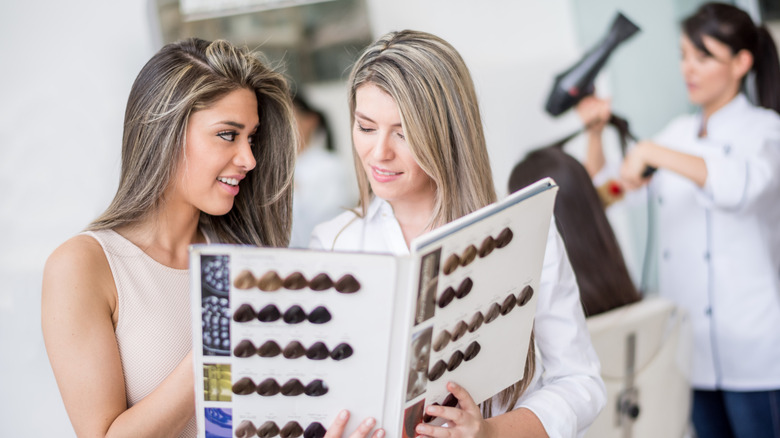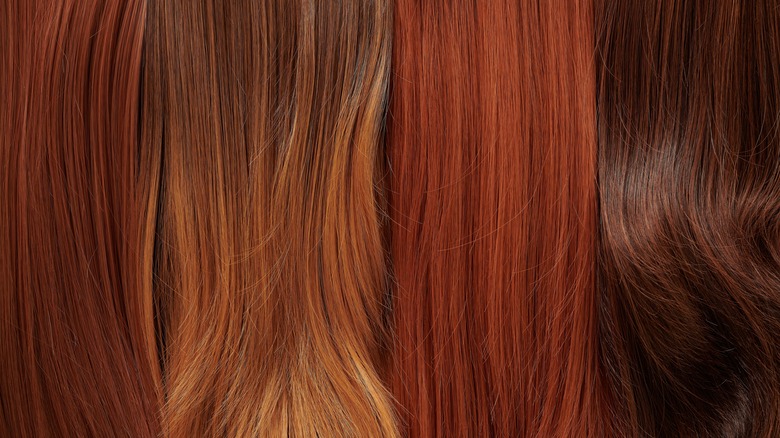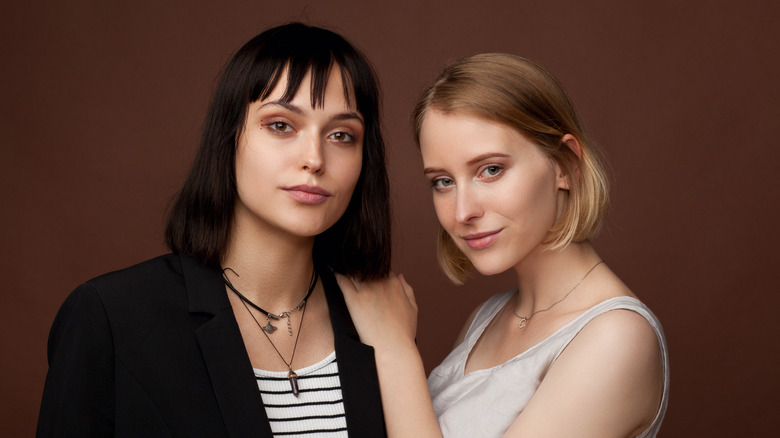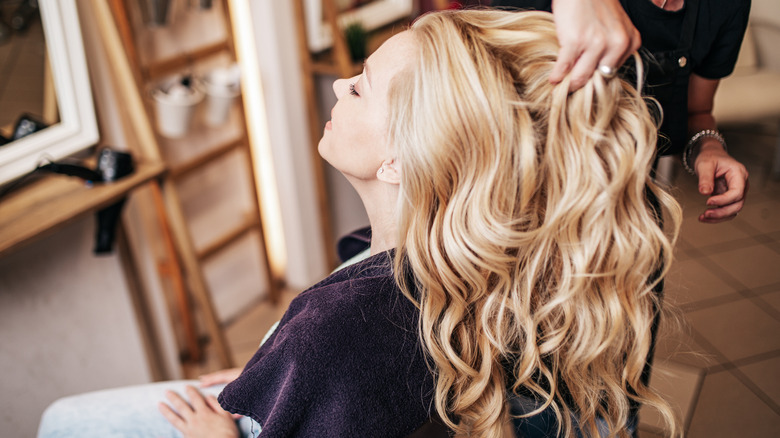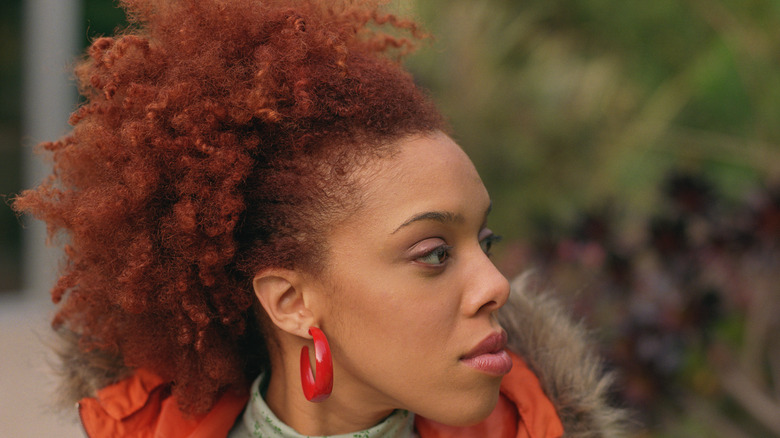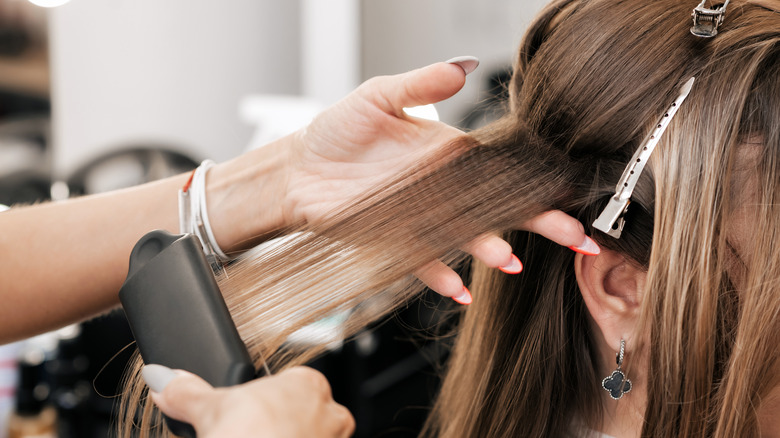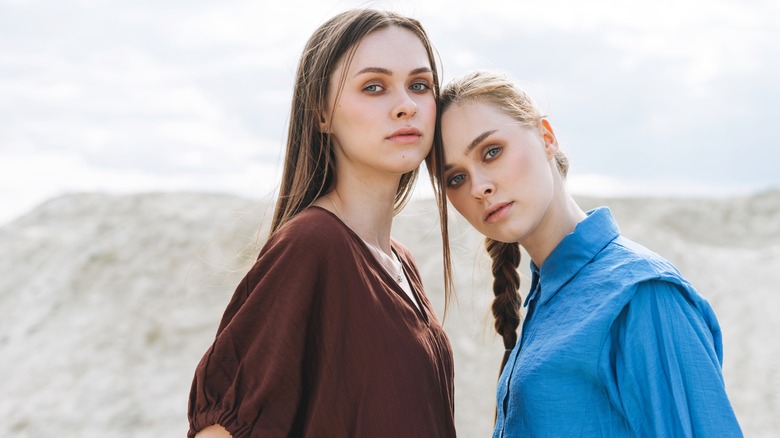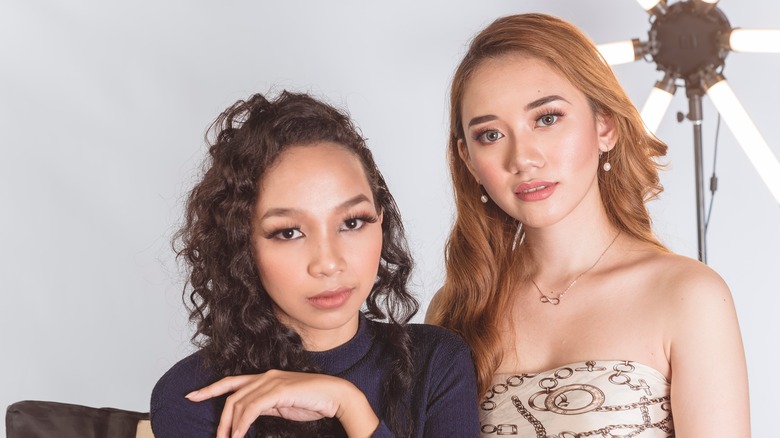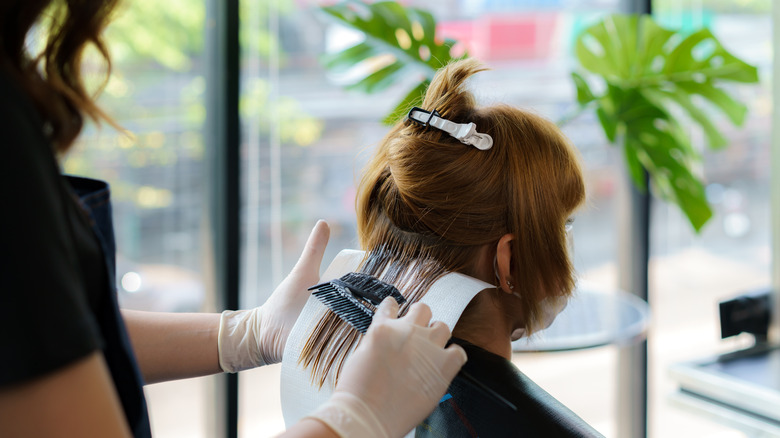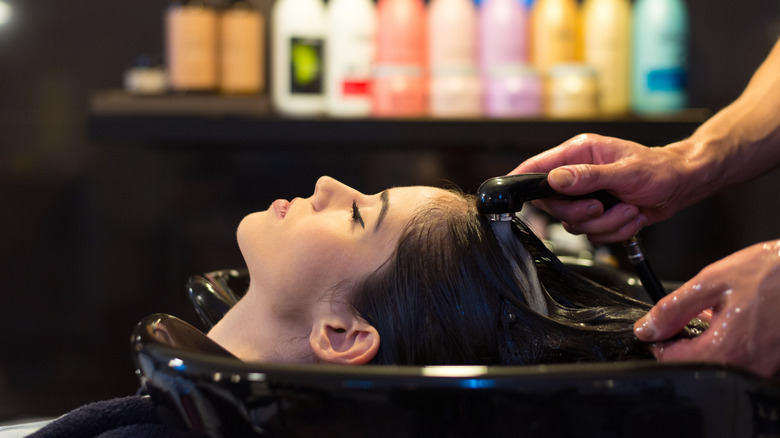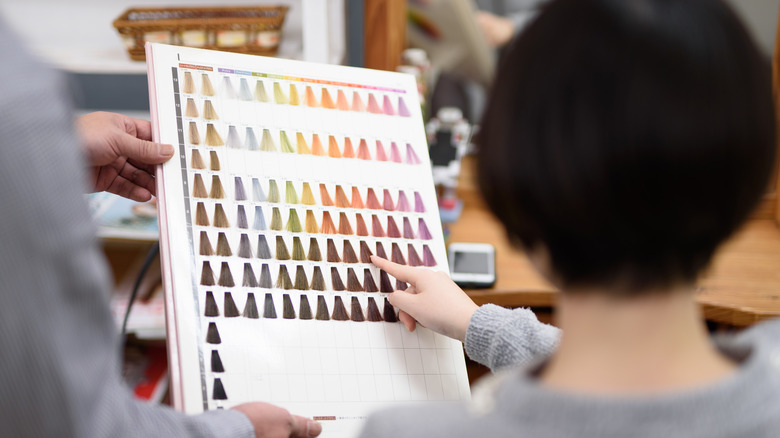How To Choose Your Next Hair Color Based On Your Season
Before picking a new hair color, getting highlights, or trying out balayage at the salon, there's a lot to consider. Changing your hairstyle, even by simply adding bangs or extra shaping, can be a big commitment, especially if you're concerned about making a hair-related faux pas.
Coloring your hair is one of the biggest changes you can make in a short amount of time (and one of the hardest to fix if you aren't happy with the results). While darker shades such as brown, auburn, and deep black are often favored in the autumn and winter months, a bleached or golden look can be the eye-catching change that you've been looking for. However, picking the most flattering shade for your hair can be more complex than you'd think.
Sometimes certain colors don't end up looking as good as you'd like, while others surprise you with how well you actually suit them. Why is that? If this is a question you often find yourself asking before your next hair appointment, it's worth thinking about the seasonal color analysis theory and which season you belong to. Here's the lowdown on what the color seasons actually mean in the beauty world and how you can choose your next hair color using the recommendations for your season.
What is seasonal color analysis?
In basic terms, seasonal color analysis is a method of styling that considers the different aspects of your natural look to help point you toward the hues that suit you best. By looking at skin undertone, eye color, and natural hair color, seasonal color theory can pick out undertones and match you with the colors that complement you. If used correctly, it can be an effective way to avoid going too dark with your next hair color or picking an undertone that clashes with the rest of your look.
When trying to figure out which season you are when picking a new hair color, many aspects of color are taken into account. Traditionally, this theory puts us into one of the four seasons: spring, summer, autumn, and winter. Springs and autumns are usually suggested to suit warmer colors, with summers and winters suiting cooler tones.
In addition to this, you can also be a dark or light season regarding the lightness of your natural hair or a soft or clear season in terms of how bright or muted your overall color is. These variants of the seasons are referred to as sub-seasons and can help you to pick your seasons if you're on the cusp between one or the other.
Understanding the different seasons
We've gone over the basics of season color theory, but how do you figure out which season you belong to? It's all about taking your eyes, undertones, and natural hair color into account. If you belong to the spring season, your natural look is all about light colors and pale to warm undertones. Springs traditionally have warmer undertones to their skin and lighter eyes, typically green, blue, or light hazel. The most common hair colors for the spring category are light auburn, pale or golden blond, warm brown, and caramel.
While summer season traits are fairly similar to spring, if you have a pinker tone to your skin, you might belong to this season instead. The summer season is all about lighter, cooler shades and naturally pale or ash-toned hair colors.
You may be more of an autumn or winter if your look is generally a bit darker. Someone in the autumn category is traditionally someone with an olive to dark skin tone, hazel or brown eyes, and darker hair with warm and golden undertones. If you have darker hair and darker eyes in cooler tones, you could be less of an autumn and more of the color theory's final season: winter. Someone in the winter season will have dark hair and dark eyes like an autumn but may have cooler undertones to their skin and hair in place of the warmth.
Warm vs. cool seasons
Once you've figured out which season you belong to, it's time to pick your new hair color ... or is it? While finding your season is fairly straightforward, the sub-seasons of each group also need to be considered. It's worth thinking about cooler shades vs. warmer shades and the saturation of these colors.
When picking your seasonal hair color, there are a few terms that you should know — warm vs. cool and soft vs. deep. Typically, a warm season is used to describe someone who suits hair with golden tones. "Hair colors with red, orange, and gold tones give a feeling of warmth and add more color to the face," hairstylist Michael Dueñas told Good Housekeeping. In contrast, a cool season is for someone who suits blue-toned shades with less warmth, like black, mahogany brown, and ice blond. A soft and deep autumn may belong to the same season but may not suit all the same colors.
As well as the undertones of your hair, you can be a soft or deep variant of one of the seasons. If you're a soft season, chances are that you'll naturally have muted and lighter undertones to your hair and little difference between your skin tone and natural hair color. A deeper season can suit the same overall shade of hair as a soft but will usually have more depth to their hair and more of a contrast between their skin tone and hair color.
Picking a hair color as a light spring
As a spring, you have a range of lighter colors to pick from when getting your hair colored. While springs are traditionally associated with golden hues and brown undertones, a light spring can suit colors that are much lighter and more vivid than this. If you're a light spring, trying peachier shades such as light strawberry blond, medium golden brown, and linen blond could be flattering. The tones in your eyes and skin should complement the lighter tones of these colors and stop you from looking washed out or dusty.
In terms of which colors to avoid as a light spring when choosing your new hair color based on your season, the rules are fairly simple. Although darker hues with cooler undertones can sometimes still be flattering, these shades can become the focal point of your entire look and overpower the natural hues of your eyes and skin.
It's best to avoid darker tones and the colors associated with autumn and winter seasons if you're wanting to best compliment your overall look. If you're looking for some celebrity inspiration, actors Blake Lively and Amanda Seyfried, as well as Taylor Swift herself, have been suggested to be light springs.
Being a warm spring means lots of golden shades
With light springs specializing in the lightest tones and peachy hues, warm springs are all about golden tones. Warm springs, also sometimes known as "true" springs, follow the colors associated with the spring to a more strict degree.
If you belong to this season, chances are that you have a golden glow to you — as such, you'll be able to pull off golden blond tones, medium auburn shades, and medium browns without washing yourself out or overpowering the rest of your look. For the hair colors to avoid, warm springs should steer away from the hues associated with autumn and winter.
Soft and muted tones, in particular, while eye-catching and flattering on those with light eyes and neutral undertones, can be a bad decision for warm springs. They run the risk of looking mismatched and overpowering the sun-kissed, golden tones of your look. Need some inspiration for your next salon visit? Check out the styling of Cameron Diaz, Nicole Kidman, and Tyra Banks, who have all been included in lists of warm springs.
Light summer colors: Neutral tones and blonds for the win
If you're a summer getting ready for your next salon appointment, it might be worth considering if you are part of the light summer season. Like springs, a light summer can pull off neutral colors and pale tones, such as shades of medium blond and light browns. For a light summer, it's important to take the pinker undertones of your skin and the very light hue of your eyes into consideration.
Auburns and any shade with a reddish undertone may clash with the hue of your skin and eyes, while extremely dark shades such as blacks and mahogany browns could wash you out. Instead, try to stick to neutral browns and ashier shades of dark blond, with highlights being an excellent way to balance these shades out.
As a light summer, you have less risk of washing yourself out and can afford to experiment more with fun shades of paler tones. One of the most common seasons in Hollywood, the light summer season, can be seen by celebrities such as Michelle Pfeiffer, Gwyneth Paltrow, and Kirsten Dunst, proving that light summers are not bound to one hairstyle or even color.
Choosing a hair color as a cool summer
The sister season to light summer, cool summer, aka "true" summer, is perhaps the most varied season of all the color sub-seasons. While someone who belongs to either season of summer will suit neutral undertones, light browns to medium browns, cool summers differ thanks to the icier tones that your general look can suit.
Along with browns, you can happily sport cooler-toned darker browns or ash blonds, or even soft platinum. Truly a season of diverse colors, it's easy to find a shade in almost every category to suit a cool summer. For an eclectic change to your hair, a light pale purple or even silver can compliment you well.
As a cool summer, it's recommended that you avoid colors with an overall warmth to avoid washing yourself out. More vibrant auburn, reds, and deep browns are shades that can draw attention away from your natural complexion. For some cool summer inspirations in the public eye, check out the stylings of Emily Deschanel, Olivia Wilde, and Emily Blunt.
From brown to red: How to pick a hair color as a soft autumn
So you're a soft autumn season — which hair color will suit you best? If you have naturally golden brown hair, you likely fit this category. And there is a range of colors that will complement autumns beautifully! Choosing a medium brown or light red will balance out the warm undertones of your skin without making your hair the overpowering focal point of your entire look.
Autumns are known for their flexibility when it comes to which colors they can wear, so going a little darker or lighter with a neutral undertone could be the way to go for you. As a soft autumn, there are some colors that it's best to avoid. Very light colors and pastels could run the risk of washing you out, while extremely vivid colors such as deep reds and blacks can overpower your look.
If you're still unsure about what shade would be best for you, check out celebrities such as Mariah Carey, Drew Barrymore, and Céline Dion and their hair color decisions. These celebs are often labeled as soft autumns by seasonal color analysts and prove that neutral colors can be just as eye-catching as deeper tones.
Darker tones: Are you a deep autumn?
When picking your new hair color as a deep autumn, it's all about darker hues of brown and warmer auburn tones. Choosing a rich copper or darker blond with warmer auburn undertones is a great way to bring out your complexion and its natural golden undertones. Unlike soft autumns, you will have more flexibility when it comes to more vivid hues and darker tones typically worn by those in the winter category.
A-listers who sport the deep autumn look can be a great source of inspiration before you make your next trip to the salon, with Rashida Jones, Brenda Song, and Cindy Crawford often assigned to this season. However, it's important to note that there is a lot more to picking a new seasonal hair color than simply matching yourself with a celebrity.
Deep autumns are recommended to avoid pastel-toned colors and ashy, cool-toned shades such as platinum blond. While eye-catching, these lighter and cooler tones can wash you out or appear mismatched with the rich hues of your eyes and skin tone.
The ideal colors for deep winters
Being a deep winter doesn't necessarily mean that you have to stick to cool-toned hues only. While winters of both the deep and cool subsections should avoid certain colors, in actuality, you can afford to try many different undertones. As deep winters are also known as "dark" winters, shades such as medium to deep browns, dark mahoganies, and dramatically dark black hair colors are recommended to suit your overall look and compliment a winter's skin and eyes.
The most unique aspect of this season is that as a deep winter, you may suit slightly warmer colors, such as mulberry and deep red, which are not suited to many of the other seasons. As a winter, the seasonal color theory does have colors that you should stay away from. It's suggested that you stay away from golden tones and overly light colors when picking a new hair look.
Going with a very golden or light tone is an easy way to make yourself look a little washed out or make an otherwise harmonious look unflattering. Another popular season amongst celebrities, deep winters such as Salma Hayek, Jodie Turner-Smith, and Sandra Bullock, prove that this sub-season has true variety.
Choosing a new hair color as a cool winter
Sometimes known as the "true" winter season, being a cool winter means that the darkest shades on the spectrum are what suit you best. Although similar to its sister shade, deep winter, cool winters can rock a range of different hair colors, from ash browns to jet blacks. If you're a winter but still unsure about which of these sub-seasons you belong to, the difference is simple.
Cool winters have much less warmth in their natural complexion than deep winters and often favor a blue undertone. When making a trip to the salon as a cool winter, the choices are varied. While dark ash browns and medium to dark browns can be flattering, you have the option to go with brown blacks and even blue-tinted black.
For the colors to avoid, cool winters should steer clear of very pale and pastel colors such as platinum blond and overly golden or almond-toned hair such as auburn and copper. Cool winter celebrities flaunting these darker shades include Katy Perry, Jada Pinkett Smith, and Selena Gomez.
Do you have to stick to the seasons?
The seasonal color theory can be a useful tool to avoid wasting money and getting stuck with a hair color you aren't happy with. But do you really have to stick to the seasons? While helpful, color theories such as this one are, of course, not mandatory. In the past, they have been criticized for a lack of diversity. The books "Color Me Beautiful" and "Color Me a Season" began the trend of color analysis in the 1970s but failed to include many different skin tones in their analysis (via CBC).
If you're having trouble deciding if you're a summer or autumn, it could be the rigidness of the original books the seasonal theory is based on that's getting in the way. It's also important to take your own personal likes into account when choosing your next hair color based on your season. Ultimately, beauty is in the eye of the beholder, so don't feel pressured to pick a color you don't like or avoid one that you love to fit your season.
In reality, seasonal color theory is a basic guideline of what may or may not suit you, depending on your features. Everyone's complexion is different, and you may not fit into one season entirely or actually suit colors that don't necessarily fall into your season. How much you want to follow the theory to a T or come up with your own hair goals is completely up to you.

